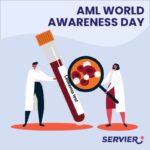
Understanding acute myeloid leukemia
Acute myeloid leukemia (AML) is a rare disease that mainly affects the elderly. It is a cancer of the blood and bone marrow that progresses rapidly in the absence of therapeutic management.

The five-year survival rate for +60-year-old patients with AML is less than 10%1
This cancer is a proliferation of immature cells, i.e., cells that are not sufficiently developed and therefore cannot function normally. These cancer cells are present in the blood, which is why we speak of “leukemia”; they come from a myeloid blast, hence the term “myeloid.”
The Canadian Cancer Society explains to us, through their video, what acute myeloid leukemia is.
Research & innovation, our leitmotif at Servier
Our ambition is clear: to accelerate the research and discovery of new therapeutic solutions, guided by a long-term vision.
Our teams mobilize every day to discover and develop medicines where patients’ needs are greatest.
Faced with the continual increase in cancer cases and the growing need for therapeutic solutions, we have made oncology one of our strategic priorities and dedicate over 70% of our R&D budget to it. Our ambition is to become a focused and innovative player in cancer treatments, particularly hard-to-treat cancers where the needs are, for the most part, not yet covered, such as AML.

We focus our R&D programs on two approaches: immuno-oncology and targeted therapies.
Collaborating with patients
In order to best meet patient needs, we work with them at every stage of the medicine lifecycle.
- Betul Oran and Daniel J. Weisdorf, Survival for older patients with acute myeloid leukemia: a population-based study, extracted on 20224-04-18.




